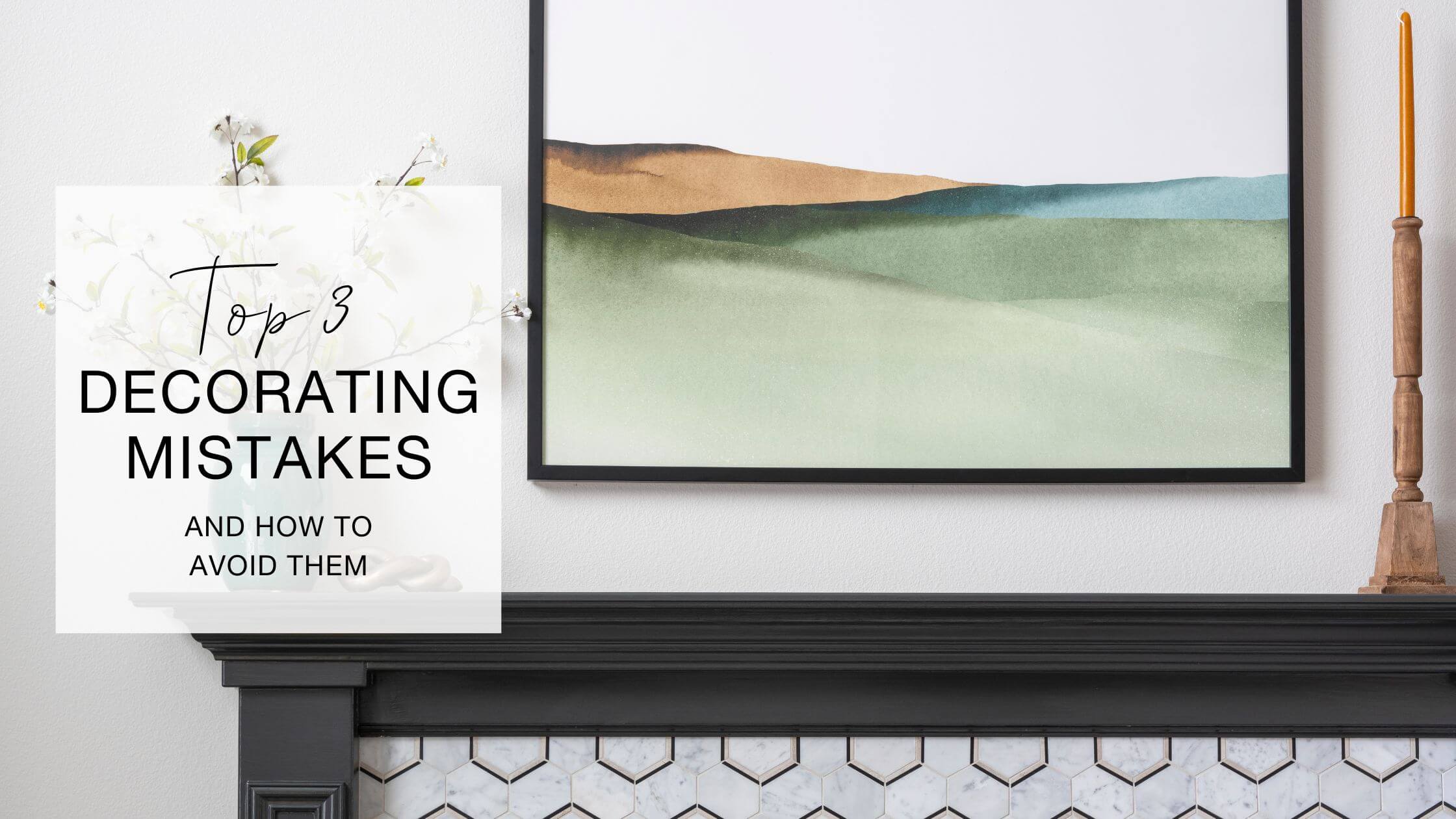
Top 3 Decorating Mistakes and How to Avoid Them!
Do you ever walk into a room, and everything just feels easy on the eyes? You may notice that the placement of the furnishings and decor feel natural and are proportionate to the space. I believe we all know this feeling and appreciate the look when we see it!
Likewise, we also recognize when it just feels off. However unique each of my clients’ needs, style, and grievances are with their home, many of them make the same decorating mistakes! These common errors have an impact on providing the inviting atmosphere that they desire from their space. I enjoy being able to teach my clients some basic decorating knowledge and help them gain confidence on re-decorating their home! Below are the top three decorating mistakes that I see and the guidance that I give my clients during our consultation. I hope you find this information as helpful as they do and remember that when it comes to decorating, these are guidelines-not rules! Every space is unique so trust your gut… or call a professional (yes, that is a shameless plug)!
Mistake #1: Short and Skimpy Drapery Panels
I get it, window sizes and standard drapery panel sizes never match up! This difference makes it nearly impossible for a quick and inexpensive fix! The reality is short curtain panels make a room feel small, and sparse panels just look unsightly; neither provide the basic functions we need or want from our window treatments! Properly sized window treatments provide privacy, control the amount of sunlight we let enter a room, and help to maintain a rooms temperature. On the decorative side, drapery panels enhance the aesthetic of the space by adding color and texture. By following the guidelines and illustration below, you can be sure to have window coverings that add beauty and function to your room.
Designer tips and tricks:
- Drapery Panels should lightly touch the floor. For uneven floors and window panels that will be opened often, I recommend floating the panel about ¼”-1/2” above the floor.
- KHID recommends hanging the curtain rod about 6”-8” above the window in rooms with high ceilings. If the space between the window and the ceiling is 12” or less, mount the rod under the ceiling to give the illusion of height.
- A curtain rod should extend 6-12” out from the side of the window to allow the maximum amount of light in! This extension will look funny if you do not have the proper curtain fullness (see below).
- For proper fullness (no skimpy curtains) multiple your window size by 2 to 2.5 to determine the overall width of curtains (and number of panels) that you will need.
- KHID’s favorite way to hang a drapery panel is by using drapery pins and curtain rings. Make sure to include these in your overall curtain length measurement!
- When purchasing panel curtains in standard sizes, round up to the longer size and have the panels altered by a seamstress. This is an inexpensive alternative to custom made curtains.

Mistake #2: Small Rugs

A rug should ground the furnishings in a room. They help to define individual spaces in a larger area, protect flooring, provide comfort, and help to regulate a rooms temperature. Because rugs can be a big expense, I find that many homeowners try to get away with the smallest rug possible. The illustration below shows some of my favorite furniture groupings and the typical rug sizes needed to create these intimate spaces, provide comfort, and protect a floor in a highly trafficked area.
Designer tips and tricks:
- Living Rooms- The front legs and at least half of the sofa or sectional should be touching the rug, but occasional chairs and accent furniture should be entirely on the rug (no one likes a wobbly side table)!
- Dining Rooms- All the chairs around the dining table should still be on the rug when pulled out. Add about 2’ to the overall measurement of your table to determine the best rug size.
- Bedrooms- Measuring 2’ around the bed (and additional seating at the foot of a bed) will help you determine the best rug size for your bedroom. KHID recommends aligning the edge of the rug with the edge of the nightstand for clean sight lines. For youth rooms and odd spaces, a runner works great next to the bed. The runner should not extend pass the end of the bed!
- Measure before you buy! I love using painters’ tape to tape off the area that needs to be covered by a rug. Rugs come in standard sizes so knowing the appropriate size speeds up your shopping time immensely.
- Don’t be afraid to layer rugs to get to the size you need! This is especially true if you have your eyes on a smaller or vintage rug that you can’t get in a large enough size.
- When you find yourself debating between two rug sizes, always choose the larger size!

Mistake #3: Incorrectly hung and disproportionate artwork and wall décor
 Art and wall décor adds major personality to a space and can be a great conversation starter at dinner parties! Hung incorrectly and out of proportion to the wall area, our eyes will bounce around the room and our artwork becomes a negative focal point. Hanging items on the wall throughout a space can be tricky, as the art will vary in size and shape. Remember that the guidelines are just that and when in doubt, use kraft paper to make templates before committing to the placement.
Art and wall décor adds major personality to a space and can be a great conversation starter at dinner parties! Hung incorrectly and out of proportion to the wall area, our eyes will bounce around the room and our artwork becomes a negative focal point. Hanging items on the wall throughout a space can be tricky, as the art will vary in size and shape. Remember that the guidelines are just that and when in doubt, use kraft paper to make templates before committing to the placement.
Designer Tips and Tricks:
- Individual artwork should be hung so that the center of the piece is at eye level, which is 57-60” high. 60” is my go-to eye level height but in kid spaces, 57” looks more natural. A general exception to this advice is for oversized wall decor, which the center of the art will be lower than “eye level”.
- Space artwork about 2-4” apart when working with an art grouping.
- When anchoring art to a piece of furniture, like a sofa or console table, you want the width of the art to be about 2/3 the size of the furniture it is anchored to and placed about 6-8” above it.
- When selecting art for a wall that is not being anchored to a piece of furniture, like in a hallway, you want the artwork or grouping of art to be a little more than half the total width of the wall. If you like math, multiply the width of the wall in inches by 0.57 and you will get an ideal width to work with. For example, 48” X 0.57=27.36 so you would want to aim for artwork that takes up about 26-30” of the wall area.
- Match the orientation of the art (horizontal or vertical) to the orientation of the wall. For example, a large horizontal wall area looks best with a horizontal piece of art or a collection of vertical frames that create the same horizontal lines when hung together. Likewise, a vertical image or a stack of horizontal prints looks best on a narrow wall.

When to Call for Help
If your find yourself wanting more advice that is specific to your project needs, let’s get a consultation scheduled! A Confidence Consultation is one of my favorite design services to offer! I love sharing decorating ideas and solutions to the many pain-points that homeowners have with their home. During a Confidence Consultation, we can do things like determine the best size furnishings for your space, discuss ways to implement a new style, and how to create cohesiveness in your home (just to name a few)! I can’t wait to work together!


